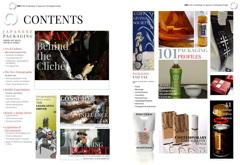Changing Packaging Trends in Japan Detailed in New Study
- Published: February 03, 2015
SINGAPORE | EP Resources Pte Ltd is offering a new market trends report, Zen & the Technology of Packaging in Japan. Authored by Stuart Hoggard, the report covers the evolving retail landscape in the country that has changed consumer shopping patterns. 
The study says Japan’s packaging industry and its brand owner customer–the FMCG (fast moving consumer goods manufacturer)–are being forced to dramatically change their formats and portion sizes and deploy new technologies such as light-weighting and downsizing their product offerings in order to secure a place on the retail shelves of the world’s second largest consumer market.
The weekly consumer-shopping trip is now uncommon in Japan. Driven by the rapid incursion of convenience stores into the suburbs, today’s Japanese consumer prefers to spread purchases across the week, dropping in to their neighborhood convenience store to pick up a few items on the way to or from work, often more than once a day
“For more than a decade, big city center department stores and supermarkets have been losing market share,” says Hoggard. “The ‘big three’ retailers, FamilyMart, Lawsons and Seven &I (7-Eleven), have been investing in opening convenience stores–konbinis, as they are known in Japan–with an average floor area of less than 100 sq m ((1,076 sq ft). By 2020, most urban Japanese will live no further than 200 meters from a convenience store operated by one of the three operators.”
Japanese consumers are developing an increasing preference for shopping in smaller volumes and closer to home. This revolution in smaller format stores means less shelf-space. Yet for a convenience store to be really convenient, it has to carry a wide product range but fewer SKUs. Retailers are aggressively deploying Just-In-Time (JIT) supply chain management and exerting pressure on their suppliers for smaller product shipments that can be unpacked faster, are easily stacked and displayed, and generate less in-store packaging waste which has to be disposed of.
Hoggard explains, “Konbinis operate a computer modeling system known as TPO: Time Place Occasion—basically predictive technology that operates in real time. The TPO system is fundamental to the expansion of these mega retail chains. This means delivering the correct product to the consumer at the correct place to match the specific occasion when the right problem is solved at the right time with a well-thought-out package in the exact outlet where it is needed. What this means for the packaging industry is a demand for product in smaller packages. “Limited shelf space means limited linear, or horizontal, product display space. Therefore packs typically taller but with a narrower footprint.”
Changes in secondary transport packaging are also subject to the new retail environment, according to Hoggard: “With several deliveries throughout the day, and little or no in-store storage space, retailers require smaller cartons.
He says, “With no space to store empty corrugated cartons, retailers are demanding attractively printed shelf-ready packaging, where the whole carton top and front can easily be tugged off, and the product placed on the shelf still in its carton—saving staff time replenishing shelf stock, and space since there are no empty brown corrugated boxes to be flattened and stored somewhere till the next delivery truck can take them away.”
Fully illustrated with more than 200 photographs and 15 data charts, the book will retail at US$595 when launched on 28 February, 2015. However the publisher is offering a 20% discount for pre-publication orders received before the publication date.












